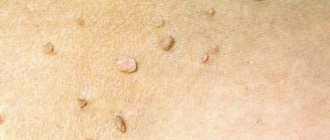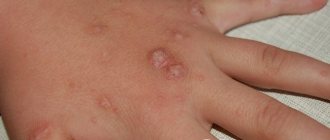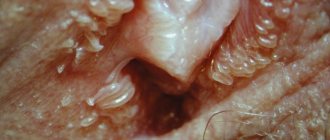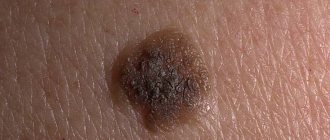Papilloma is a benign neoplasm ; it appears on the skin and mucous membranes when the human papillomavirus (HPV) is activated. Most people are carriers of this virus, but it does not always manifest itself. The development of papillomas occurs against the background of decreased immunity , which can be triggered by stress, hypothermia, infection and other unfavorable factors.
Papillomas can be located throughout the body, but the most common places for their localization are the face, neck, décolleté, and armpits.
Is it possible to remove papillomas on the body and face?
Initially, papilloma is a benign neoplasm. However, there are a number of reasons why its cells can degenerate into cancer:
- Injury due to scratching;
- Friction against hard clothing;
- Damage during sexual intercourse (papillomas on the genitals);
- Frequent exposure to the sun and more.
But even if there is no such effect on the tumors, if they are detected, you should contact the clinic as soon as possible for removal.
Virus prevention
There is an opinion that papillomas are not “harmful” to humans, they are purely a cosmetic drawback. Medical practice proves the opposite: their presence is a consequence of HPV infection, and lack of treatment can lead to serious consequences, one of the most dramatic being the development of malignant tumors. That is why doctors recommend removing tumors using a complex method, including surgery and medication.
To minimize the likelihood of HPV infection, you must follow the following recommendations from experts:
- do not walk barefoot in places where it is warm and humid (bathhouse, swimming pool, shared shower): these locations are the most favorable environment for viruses and bacteria to live.
- Use condoms during sexual intercourse (they reduce the likelihood of contracting HPV and infection by 70%), avoid casual intimate relationships.
- Be careful when choosing beauty salons, avoid places where sterility is treated carelessly.
- Do not use hygiene items (toothbrush, washcloth, comb, etc.) and clothing of a person infected with the HPV virus.
- Timely cure colds that lead to decreased immunity.
- Be sure to coordinate the use of hormonal contraceptives with your doctor: they can lead to hormonal imbalance.
Healthy lifestyle rules will help you avoid HPV infection, including giving up bad habits, moderate physical activity, regular walks in the fresh air, ensuring a sufficient amount of vitamins and minerals in your diet, and maintaining good personal hygiene.
Which method of papillomas removal should you choose?
In modern medicine, several methods are used to eliminate skin tumors:
- Classic surgery - removal with a scalpel, the most effective method, which is not used often due to the high likelihood of scar formation;
- Laser therapy - exposure to a high-frequency light beam, which allows you to remove the tumor layer by layer without a trace. At the same time, the beam cauterizes the edges of the vessels to eliminate the possibility of bleeding and infection;
- Thermal coagulation - cauterization with high-frequency electric current with simultaneous sealing of blood vessels;
- Cryotherapy - freezing with liquid nitrogen or carbonic acid and then removing dead tissue.
A dermatologist and surgeon will help you choose a method. Experts make a choice based on the following factors:
- Papilloma size;
- Number and spread of localization;
- Test results;
- Patient's personal preference.
Treatment of recurrent papillomatosis
It is not always possible to cure papillomas once and for all. In people with reduced immunity, endocrine disorders and chronic diseases of internal organs, growths may appear again and again. If this happens, you should consult your doctor.
The use of antiviral immunomodulatory drugs will help suppress the virus in the body. The most commonly prescribed drugs are Isoprinosine (Inosine Pranobex), Cycloferon, Viferon, Polyoxidonium, Panavir. It is also recommended to take a monthly course of multivitamins twice a year.
Is it possible for pregnant women to remove papillomas?
Pregnancy is a contraindication to most surgical interventions, including wart removal. Therefore, most often doctors prefer not to operate on pregnant women, choosing observation tactics.
Papillomavirus does not affect the course of pregnancy and the condition of the fetus. It is activated due to hormonal changes and decreased immunity. Over time, after childbirth, warts may disappear on their own when the hormonal levels and resistance of the woman’s body normalize. Until this time, you should wear loose, soft clothing without metal inserts. It is better to choose breathable, natural fabrics so as not to injure the skin and ensure that it is free from excess moisture.
However, there are exceptions in which removal of papillomas during pregnancy is necessary:
- Growths in the genital area that cause increased discharge - elimination is necessary to eliminate the threat of infection of the child during delivery;
- Changes in the color and structure of papilloma;
- Location where injury to the growth is inevitable;
- Itching and other discomfort.
In these situations, the dermatologist prescribes the most gentle removal: laser, electrocoagulation. For hanging papillomas, it is possible to cut off a thin stalk, which is often done without anesthesia. The pain lasts a fraction of a second and the use of an anesthetic is inappropriate. Further treatment with medications is determined by the doctor individually. Most women are not prescribed it due to the effect of the drug on the fetus. At the same time, the doctor recommends preventive measures: take vitamins, eat well, avoid stress and hypothermia, regularly visit not only a gynecologist, but also a dermatologist.
Main cause of the disease
Papilloma is a pathological growth of the epithelium formed by accelerated cell division. It is located on various parts of the body, right down to intimate areas and internal mucous membranes. It has a variety of forms, which depend on the type of causative agent of the disease, but most often they are compared to a cockscomb, pointed papillae or cauliflower.
As a rule, they are found where the epithelium is most susceptible to microtrauma: on the extremities, in the groin, in women in the area where the elastic bands of the bra are located. Often there are also close to the lymph nodes (armpits, neck), which are storage areas for all sorts of debris in the body.
They are caused by the human papillomavirus (HPV). At least 90% of the world's population is infected with it. There are more than 70 types of HPV, which have various consequences for human health.
HPV is transmitted by penetration through the smallest microtraumas of the skin and mucous membranes.
Is it worth removing papilloma from a child?
To date, doctors do not have a consensus on this matter. Some experts believe that it is impossible to touch tumors at an early age. They monitor the babies, taking into account changes in tumors, growth in their number and other features. Only warts that are inflamed or quickly spreading are removed.
There is also an opposite opinion - papillomas in children should be removed immediately after detection. Its supporters fear injury to the wart and heavy bleeding, as well as rapid degeneration into cancer. In children, this likelihood is high due to increased activity and frequent falls.
All doctors call for prompt initiation of conservative therapy. Immunomodulators and vitamins are prescribed, and ointments and lotions are applied topically. The duration of the course, dosage and frequency of administration are determined by the doctor individually.
All experts also agree that warts should be removed if a child or teenager has complexes about their appearance. Also, neoplasms in the larynx that cause the risk of suffocation are immediately eliminated.
The choice of method is made by the doctor. Surgical treatment is used extremely rarely; gentle methods are more often chosen: laser or electrocoagulation.
Surgical excision with a scalpel
Removal of papillomas with a scalpel during classical surgery is used quite rarely, mainly when signs of malignancy of the tumor are detected. In this case, the surgeon excises the papillomatous growths, capturing healthy skin.
The method is traumatic and leaves scars and stains. If desired, they can be removed using laser and other cosmetic procedures, including acid peels. Experts try not to use surgical excision of papillomas on open areas of the body and face.
Is it possible to remove papillomas in the summer?
In emergency situations, doctors prescribe surgery at any time of the year, even in summer. However, if the tumor does not cause serious problems, it is better to wait out the heat period. The fact is that heat and active ultraviolet radiation make tissue restoration difficult. At the site of the removed papilloma, a crust forms, which, falling off, leaves behind thin young skin. It is not able to withstand the effects of sunlight and is prone to pigmentation and inflammation. If it is still necessary to remove papilloma in the summer, it is advisable not to be in the sun, wear closed clothes, a hat, and use a cream with ultraviolet protection.
Why get rid of growths
Do papillomas need to be removed? Benign formations are mostly harmless when a person has a good immune system, is resistant to stressful situations and leads a healthy lifestyle without smoking, drinking alcohol, using drugs and herbs that intoxicate the human mind.
Is it possible to remove growths? Getting rid of papilloma depends on its location and the nature of its course. If the growth does not cause any inconvenience to a person, you can leave it as is, the main thing is to take courses of immunomodulatory medications. If the tumor develops into a malignant formation, getting rid of it is mandatory. In addition, it is important to know which papillomas can be removed. All benign and malignant formations can be removed at the patient’s request.
Attention! You cannot get rid of papillomas on the face and neck on your own; scars may remain.
There is more than one way to remove growths. Consider the available methods today, but first, find out the answer to the question: “Is this necessary?” Of course, it is necessary, having removed the papilloma, the patient will not be embarrassed to undress on the beach or go outside, thinking that every passerby will look at the formation.
Is it possible to remove it in summer? You can get rid of the growth that spoils your appearance at any time.
Is it possible to remove papilloma yourself?
There is no way to get rid of warts at home. Tightening the papilloma with a thread, cutting off the stalk, burning it with vinegar and similar procedures actually lead to the fact that part of the neoplasm disappears. But the root remains in the skin, and the virus provokes increased division of pathological cells. As a result, instead of one papilloma, several grow, and an infection attaches to the injured skin, inflammation and suppuration begin. Damage to the papilloma can lead to accelerated cell malignancy, especially if it was caused by an oncogenic virus. Given these probabilities, you should not pick or cut off a wart at home. In case of accidental injury or detachment of a papilloma, you should contact the clinic as soon as possible.
Cryodestruction
Cryodestruction is the freezing of tumors with liquid nitrogen. This gas liquefies at extremely low temperatures. Exposure to cold leads to cell death and coagulation of proteins inside the papilloma.
Nitrogen is applied to a stick with cotton wool. In some cases, a special nozzle is used from which liquefied gas is supplied. Then the specialist touches the growth with the applicator and holds it for several seconds. Under the influence of cold, the neoplasm is destroyed.
After the procedure, the papilloma first turns pale, then swells and turns red. After 24 hours, a bubble appears in its place. Under no circumstances should it be pierced, otherwise a scar may remain. The bubble resolves on its own within 7 days. Then a crust appears in its place, and after it falls off, a pink spot remains. Over time, the skin color becomes even. It is recommended to treat the postoperative field with salicylic alcohol.
This method has the following advantages:
- no need for anesthesia;
- Possibility of use in children;
- painlessness;
- sterility.
Cryodestruction is contraindicated during pregnancy, as well as in case of infectious pathologies and exacerbation of any chronic diseases.
The disadvantages of the method include the impossibility of microscopy of papilloma tissue, since the wart is completely destroyed. If the tumor is located deep under the skin, several sessions of cryodestruction may be required.
What is better to remove papillomas - laser or nitrogen? With the help of laser beams you can get rid of larger papillomas. Only small warts can be treated with liquid nitrogen. In addition, the laser affects the tumor more accurately than an applicator with liquid nitrogen. Therefore, the risk of scar formation is lower than with cryodestruction.
When papillomas cannot be removed
In addition to pregnancy, there are several other contraindications to the removal of papillomas:
- Oncological diseases;
- Cold;
- Herpes in the area where papillomas are localized;
- Strong fresh tan on the skin;
- Diabetes.
Even if there are no signs of these conditions, consultation with a dermatologist is necessary before surgery.
Attention!
This article is posted for informational purposes only and under no circumstances constitutes scientific material or medical advice and should not serve as a substitute for an in-person consultation with a professional physician.
For diagnostics, diagnosis and treatment, contact qualified doctors! Number of reads: 250 Date of publication: 06/15/2018
Dermatologists - search service and appointment with dermatologists in Moscow
Which doctor should you contact for medical help?
If the papilloma is too large, do not try to get rid of it yourself, especially when inflammation or suppuration is present. In this situation, it is better to seek advice from a highly qualified specialist. Which doctor removes growths and diagnoses?
If papillomas are detected on the skin, you should contact a gynecologist, urologist, dermatologist or andrologist. If malignant degeneration has been diagnosed, specialists will refer you to an oncologist to confirm the diagnosis to find out whether the growth is life-threatening for the patient. Then treatment is prescribed.
Is it painful to remove papillomas in an intimate area or other areas of the skin? Before performing a procedure to remove a growth on a patient, the doctor uses anesthesia. Removal is painless, but a little unpleasant. After getting rid of the formation, the papillomas are sent for histology to make sure whether the growth was cancerous or not.











